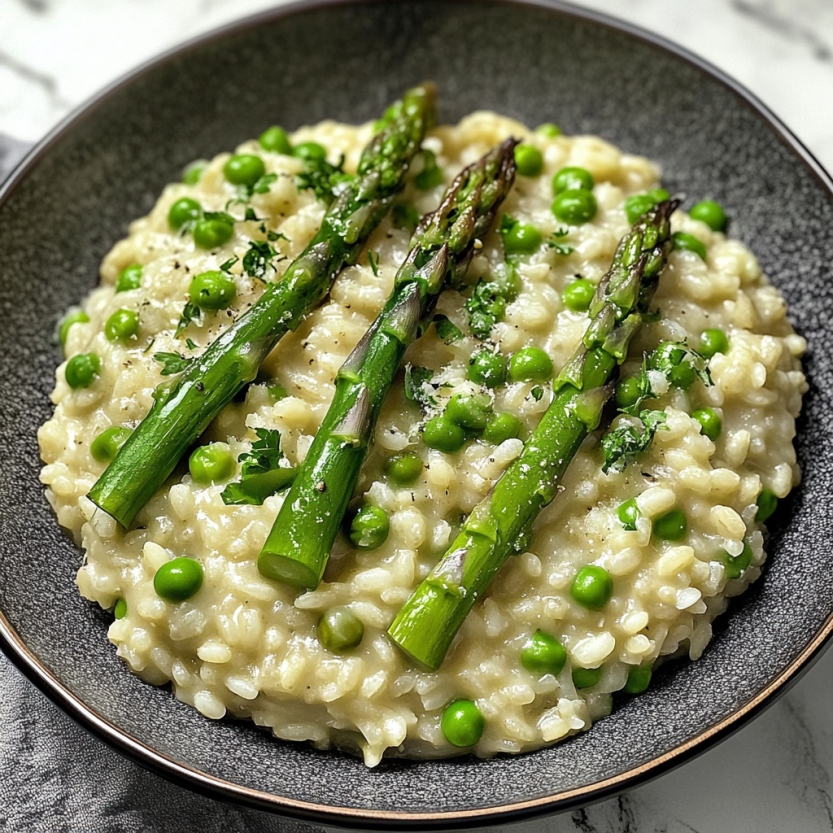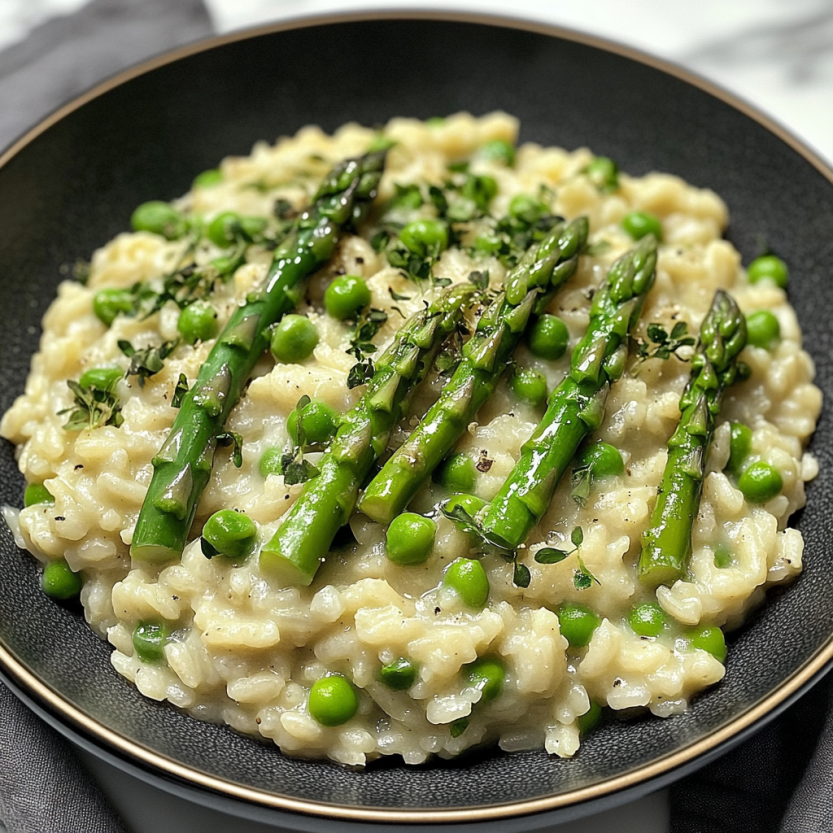 Save
Save
This asparagus and pea risotto transforms seasonal spring vegetables into a luxurious dish that balances creamy comfort with fresh, vibrant flavors. The tender asparagus adds a subtle earthy note while sweet peas bring brightness to this Italian classic.
I first made this risotto during a spring cooking class in Florence, and the simplicity of letting seasonal ingredients speak for themselves completely changed my approach to Italian cooking. Now it's my go-to dish whenever asparagus first appears at the farmers' market.
Ingredients
- Arborio rice: A short-grain rice with high starch content that creates the signature creamy texture without cream. Look for grains with a pearly white center.
- Medium onion finely chopped: The aromatic foundation of any good risotto. Choose firm onions with dry papery skins.
- Garlic minced: Fresh garlic provides a subtle background flavor. Select firm bulbs with no sprouting.
- Vegetable broth: The liquid that gradually transforms into creamy goodness. Homemade provides the best flavor but good quality store-bought works well.
- Asparagus trimmed and cut into 1-inch pieces: The star of the show. Look for bright green stalks with closed, compact tips.
- Fresh or frozen peas: Sweet little bursts of spring flavor. Fresh in-season peas are incredible but frozen work perfectly year-round.
- White wine: Optional but adds wonderful acidity and depth to balance the creaminess. Use a crisp variety you would drink.
- Parmesan cheese or nutritional yeast: Adds umami richness and helps bind the risotto. Always grate fresh from a block for best flavor.
- Olive oil: Use a good quality extra virgin olive oil for the best flavor foundation.
- Fresh parsley for garnish: Adds a pop of color and fresh herbal notes. Italian flat-leaf variety has the best flavor.
Step-by-Step Instructions
- Prepare the broth:
- Heat the vegetable broth in a saucepan and keep it warm over low heat. Having warm broth is crucial as cold liquid would halt the cooking process each time you add it to the rice. Keep it gently simmering but not boiling.
- Create the flavor base:
- In a large heavy-bottomed skillet or Dutch oven, heat the olive oil over medium heat until it shimmers. Add the finely chopped onion and minced garlic, cooking gently for 5-7 minutes until they become translucent and aromatic but not browned. This slow cooking develops sweet notes in the onions that form the foundation of your risotto.
- Toast the rice:
- Add the Arborio rice to the pan with the sautéed aromatics and stir continuously for 1-2 minutes. This crucial toasting step creates a protective coating on each grain that helps the rice release its starch slowly and maintain its structure during cooking. The rice should become slightly translucent around the edges but remain white in the center.
- Deglaze the pan:
- If using wine, pour it into the hot pan with the rice and stir constantly as it sizzles and absorbs. The alcohol will cook off leaving behind bright acidity and depth of flavor. Let it absorb completely before moving to the next step.
- Begin the risotto method:
- Add your first ladle of warm broth to the rice, stirring gently but consistently. Keep the heat at medium so the liquid simmers but doesn't boil away too quickly. Wait until most of the liquid has been absorbed before adding the next ladle. Continue this rhythmic process of adding broth and stirring, creating the creamy texture as the rice releases its starch.
- Incorporate the vegetables:
- After about 15 minutes when the rice is halfway cooked, gently fold in the asparagus pieces and peas. The timing is perfect as these spring vegetables need just enough cooking to become tender while maintaining their vibrant color and nutritional value.
- Finish the risotto:
- Continue adding broth and stirring until the rice reaches the perfect al dente texture about 20-25 minutes total cooking time. The grains should be tender but still have a slight firmness at the center. The risotto should flow gently when you tilt the pan, not stand stiffly.
- Final enrichment:
- Remove the pan from heat and immediately stir in the grated Parmesan cheese or nutritional yeast. Season thoughtfully with salt and freshly ground black pepper, tasting as you go. The cheese will melt into the hot risotto, creating additional creaminess and a wonderful savory depth.
 Save
Save
My grandmother taught me that risotto should gently ripple like waves when you shake the pan rather than standing firm like mashed potatoes. This simple visual cue has saved me from countless batches of overcooked risotto.
The Secret to Perfect Risotto
The magic of risotto lies in the gradual addition of liquid and patient stirring. Many home cooks rush this process by adding too much broth at once. Taking your time allows each grain to release its starch slowly, creating that signature creamy texture without cream. Think of it as a meditative cooking process. Pour a glass of wine, put on some music, and embrace the rhythm of stirring. Your patience will be rewarded with risotto that rivals any Italian restaurant.
 Save
Save
Seasonal Variations
This basic method can be adapted throughout the year by swapping the vegetables. In summer, try fresh corn and cherry tomatoes. Fall brings opportunities for butternut squash and sage. Winter versions shine with wild mushrooms and thyme. The technique remains the same while the flavors evolve with what's at peak freshness. This adaptability is what makes risotto such a valuable recipe in any cook's repertoire.
Make It Ahead
While traditionalists insist risotto must be made and served immediately, there are ways to prepare it partially in advance. You can cook it until it's about 75% done, then spread it on a baking sheet to cool quickly. Refrigerate this partially cooked risotto for up to two days. When ready to serve, return it to the pan, add hot broth, and continue the cooking process. The texture won't be quite as perfect as freshly made, but it's a practical solution for entertaining.
Recipe Questions
- → Can I make this risotto vegan?
Yes! Simply substitute the Parmesan cheese with nutritional yeast for a similar umami flavor. The nutritional yeast will still provide a cheesy taste while keeping the dish completely plant-based. Also ensure your vegetable broth is vegan-friendly.
- → What's the secret to creamy risotto?
The key to creamy risotto is patience during the cooking process. Add warm broth gradually and stir frequently to release the rice's starches. Using Arborio rice specifically is essential as its high starch content creates that signature creamy texture while maintaining an al dente bite.
- → Can I substitute other vegetables?
Absolutely! While asparagus and peas are perfect spring combinations, you can adapt this dish year-round with seasonal vegetables. Try mushrooms and spinach in fall, butternut squash in winter, or cherry tomatoes and zucchini in summer.
- → Can I make risotto ahead of time?
Risotto is best enjoyed immediately after cooking when the texture is perfect. However, you can par-cook it until it's about 80% done, then cool and refrigerate. When ready to serve, bring it back to heat with a little extra warm broth and finish cooking until creamy and tender.
- → Is white wine necessary in this dish?
The white wine adds acidity and depth of flavor, but it's completely optional. If omitting, simply start adding the vegetable broth right after toasting the rice. You can also add a small splash of lemon juice at the end for brightness if desired.
- → What's the best way to prepare asparagus for risotto?
Trim the woody ends of asparagus by bending each spear until it naturally snaps. Then cut the tender portions into 1-inch pieces. For thicker asparagus, you may want to briefly blanch them before adding to the risotto to ensure they're perfectly tender.